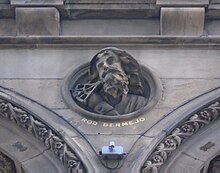Rodrigo de Triana
This article needs additional citations for verification. (December 2015) |
You can help expand this article with text translated from the corresponding article in Spanish. (June 2016) Click [show] for important translation instructions.
|

Rodrigo de Triana (born 1469 in Lepe, Huelva, Spain) was a Spanish sailor, believed to be the first European since the Vikings to have seen the Americas. Born as Juan Rodrigo Bermejo, Triana was the son of hidalgo and potter Vicente Bermejo and Sereni Betancour.
On October 12, 1492, while on Christopher Columbus' ship La Pinta, he sighted a land which was called by the natives, Guanahani.[1] After spotting the Bahamian island at approximately two o'clock in the morning, he is reported to have shouted "¡Tierra! ¡Tierra!" (Land! Land!). Columbus claims in his journal that he saw "light" at 10 p.m. the previous day, "but it was so indistinct that he did not dare to affirm it was land."[1] Triana went without reward as Columbus took credit for his find.[2]
After his return to Spain, Triana sailed into Africa and became a Muslim.[3]
NASA's Deep Space Climate Observatory, a satellite originally intended to provide a near-continuous view of the entire Earth, was initially named Triana, after Rodrigo de Triana.

Footnotes
- ^ a b "Esta tierra vidó primero un marinero que se decía Rodrigo de Triana, puesto que el Almirante a las diez de la noche, estando en el castillo de popa, vidó lumbre aunque fue cosa tan cerrada que no quiso afirmar que fuese tierra." — The Diary of Christopher Columbus
- ^ Nabhan, Gary Paul (2014-04-07). Cumin, Camels, and Caravans: A Spice Odyssey. Univ of California Press. ISBN 9780520956957.
- ^ Helps, Arthur (1856). The Spanish Conquest in America: Vol I. New York: Harper & Brothers. p. 115.
